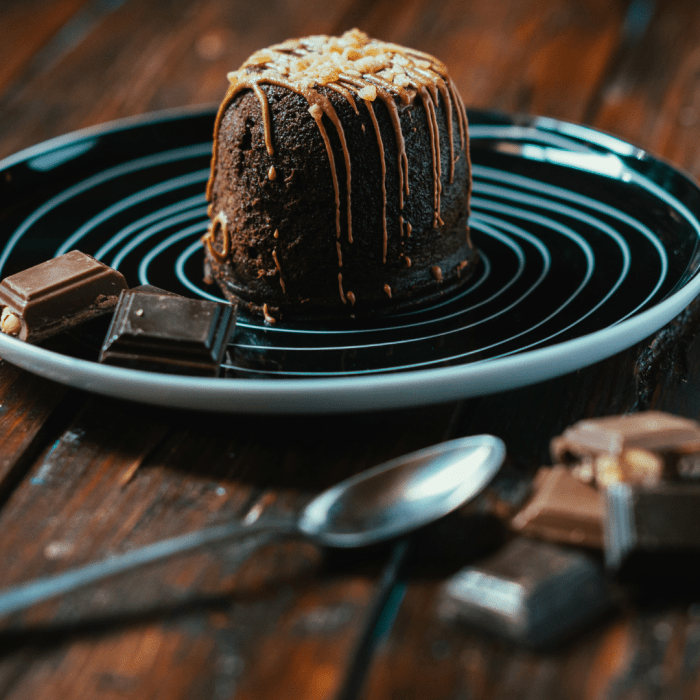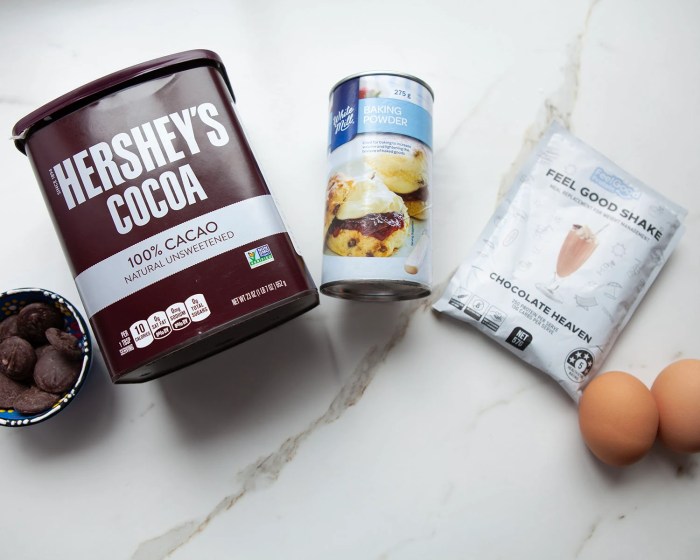Ingredient Breakdown and Nutritional Impact: Lava Cake Nutrition Facts

Lava cake nutrition facts – Lava cakes, renowned for their molten chocolate center and rich texture, derive their unique characteristics and nutritional profile from a specific combination of ingredients. Understanding the contribution of each component is crucial for assessing the overall nutritional value of this decadent dessert.
A typical lava cake recipe relies on a relatively small number of key ingredients, each playing a vital role in the final product. The interplay of these ingredients determines not only the taste and texture but also the nutritional content of the cake. Variations in ingredients, such as the type of chocolate used, can significantly alter the nutritional profile.
Typical Ingredients and Their Nutritional Contributions
The core ingredients of a standard lava cake recipe include flour, sugar, butter, eggs, and chocolate. Each contributes distinct nutritional properties:
- Flour: Provides structure and texture to the cake. It contributes carbohydrates, primarily in the form of starch, offering energy. The type of flour used (e.g., all-purpose, cake flour) can slightly affect the nutritional profile.
- Sugar: Contributes sweetness and enhances the browning process. It is a significant source of carbohydrates and calories, offering readily available energy but lacking essential nutrients.
- Butter: Adds richness, flavor, and moisture. It is a major source of fat, primarily saturated fat, and contributes significantly to the calorie count. Butter also provides some fat-soluble vitamins.
- Eggs: Bind the ingredients together, contribute to the structure, and add richness. They provide protein and some essential nutrients, such as choline.
- Chocolate: The star ingredient, contributing intense flavor and the characteristic molten center. The type of chocolate (dark, milk, or semi-sweet) significantly impacts the nutritional content, affecting the fat, sugar, and antioxidant levels. Dark chocolate generally contains more antioxidants and less sugar than milk chocolate.
Nutritional Comparison of Lava Cake Variations, Lava cake nutrition facts
The nutritional profile of a lava cake can vary considerably depending on the specific recipe and ingredients used. One key factor influencing the nutritional content is the type of chocolate. Dark chocolate lava cakes, for instance, tend to have a higher percentage of cocoa solids, resulting in a higher concentration of antioxidants and potentially a lower sugar content compared to milk chocolate versions.
However, dark chocolate often contains a higher fat content.
Nutritional Information per Serving
The following table provides an estimated nutritional breakdown for a typical serving of a standard lava cake recipe. Note that these values are approximate and can vary based on specific ingredients and portion size.
| Nutrient | Amount per Serving |
|---|---|
| Calories | 300-400 |
| Fat (g) | 15-25 |
| Protein (g) | 4-6 |
| Carbohydrates (g) | 30-40 |
| Sugar (g) | 15-25 |
Calorie and Macronutrient Content
Lava cakes, renowned for their rich, decadent texture and molten chocolate center, present a unique nutritional profile. Understanding the calorie and macronutrient composition of a typical serving is crucial for informed dietary choices. This section details the macronutrient breakdown of a standard lava cake and explores the impact of ingredient substitutions on its overall nutritional content.
A standard serving of a classic lava cake typically contains a significant amount of calories, primarily derived from its fat and carbohydrate content. The precise values can vary depending on the specific recipe and ingredients used, but a general understanding of the macronutrient distribution provides a valuable framework for dietary planning.
Macronutrient Composition of a Standard Lava Cake Serving
The following bullet points illustrate the approximate macronutrient composition of a single serving of a typical lava cake. These values are estimates and may vary based on recipe variations.
- Carbohydrates: A significant portion of the calories in a lava cake comes from carbohydrates, primarily from sugar and flour. Expect a range of 25-40 grams of carbohydrates per serving.
- Fats: The high fat content contributes significantly to the rich texture and flavor of the lava cake. This is largely due to the butter and chocolate used in the recipe. Fat content can range from 20-35 grams per serving.
- Proteins: The protein content in a lava cake is relatively low compared to carbohydrates and fats. Expect approximately 3-7 grams of protein per serving, primarily from the eggs and flour.
Calorie Distribution Visualization
The calorie distribution among macronutrients can be visualized using a simple text-based chart. Imagine a circle representing the total calories in a lava cake (approximately 300-450 calories depending on the recipe). This circle is then divided into three segments, proportionally representing the caloric contribution of carbohydrates, fats, and proteins. For example, if a lava cake has 400 calories, and carbohydrates contribute 150 calories, fats contribute 200 calories, and protein contributes 50 calories, the chart would show a large segment for fats (half the circle), a smaller but still substantial segment for carbohydrates (slightly less than half), and a small segment for proteins (one-eighth of the circle).
This visual representation clearly demonstrates the dominance of fats and carbohydrates in the overall calorie composition of a lava cake.
Impact of Ingredient Substitutions
Substituting ingredients can significantly alter the calorie and macronutrient content of a lava cake. Making healthier choices can reduce the overall calorie count and improve the nutritional profile.
Let’s explore lava cake nutrition facts! Understanding the calorie and fat content is key to enjoying this decadent dessert in moderation. For comparison, you might also want to check out the nutritional information for other rich treats, like king cake nutrition facts , to see how they stack up. Returning to lava cakes, remember portion control is your friend when indulging in these delicious, intensely chocolatey delights.
For instance, using whole wheat flour instead of all-purpose flour will increase the fiber content and slightly reduce the overall carbohydrate content. Reducing the amount of sugar will directly lower the carbohydrate and calorie count. Substituting some of the butter with applesauce or unsweetened applesauce can also reduce the fat content, albeit potentially affecting the texture and taste.
Using dark chocolate with a higher percentage of cocoa solids will increase the antioxidant content and potentially reduce the overall sugar content compared to using milk chocolate. These modifications can lead to a healthier lava cake with a lower calorie and fat content, while still retaining some of its signature richness.
Lava Cake and Dietary Considerations

Lava cake, while undeniably delicious, presents challenges for individuals adhering to various dietary restrictions or managing specific health conditions. Its typical composition, rich in butter, sugar, and flour, makes it inherently high in calories, saturated fat, and refined carbohydrates. However, with careful ingredient substitutions and adjustments, it is possible to create more inclusive versions of this decadent dessert.
Adapting Lava Cake Recipes for Dietary Restrictions
The nutritional profile of lava cake can be significantly altered to accommodate various dietary needs. For example, vegan lava cakes utilize plant-based butter substitutes, such as vegan margarine or coconut oil, along with egg replacements like applesauce or flaxseed meal. Gluten-free versions substitute traditional wheat flour with gluten-free blends containing almond flour, coconut flour, or a combination of other gluten-free flours.
Reducing the sugar content requires substituting a portion of the sugar with alternative sweeteners such as stevia or erythritol, though this may affect the texture and overall sweetness. It is crucial to note that these modifications may impact the cake’s texture and taste; experimentation with different ratios and ingredients is often necessary to achieve the desired result.
Lava Cake and Individuals with Diabetes
Individuals with diabetes must carefully consider the high sugar and carbohydrate content of traditional lava cake. The rapid digestion and absorption of these components can lead to significant blood glucose spikes. To mitigate this, portion control is essential. Additionally, incorporating ingredients that slow down glucose absorption, such as incorporating cinnamon or using a blend of different flours, may be beneficial.
However, it’s important to consult with a healthcare professional or registered dietitian for personalized dietary advice. They can help determine appropriate portion sizes and modifications to fit individual metabolic needs and blood glucose control goals.
Lava Cake and Cardiovascular Health
The high saturated fat content in traditional lava cake is a concern for individuals with cardiovascular disease or those at risk. Saturated fats can contribute to elevated cholesterol levels, potentially increasing the risk of heart disease. Modifying the recipe to use unsaturated fats, such as olive oil or avocado oil, in place of butter can help reduce the saturated fat content.
Furthermore, reducing the overall fat content while maintaining moisture can be achieved through careful adjustments to the recipe. As with diabetes, consulting a healthcare professional or registered dietitian is advisable for personalized dietary recommendations, especially considering individual risk factors and health conditions.
Question & Answer Hub
Can I make a healthier lava cake?
Yes! Substitute whole wheat flour for all-purpose, reduce sugar, and use dark chocolate for a richer flavor with less added sugar. Consider using applesauce or mashed banana to reduce the amount of butter or oil needed.
Is lava cake suitable for diabetics?
Lava cake is high in sugar and carbohydrates, making it unsuitable for many diabetics. Consult your doctor or a registered dietitian for personalized advice. Small portions, infrequent consumption, and careful blood sugar monitoring might be considered if you have diabetes.
Are there gluten-free lava cake options?
Absolutely! Use gluten-free flour blends in place of all-purpose flour to create a delicious gluten-free version. Ensure the chocolate and other ingredients are also certified gluten-free.
How many calories are in a typical serving of lava cake?
The calorie count varies greatly depending on the recipe and serving size. A typical serving can range from 300-500 calories or more.

